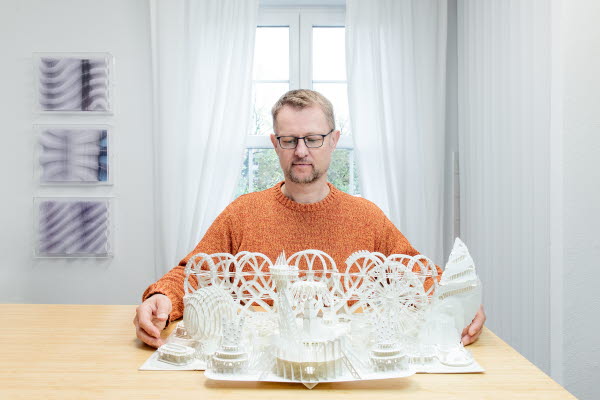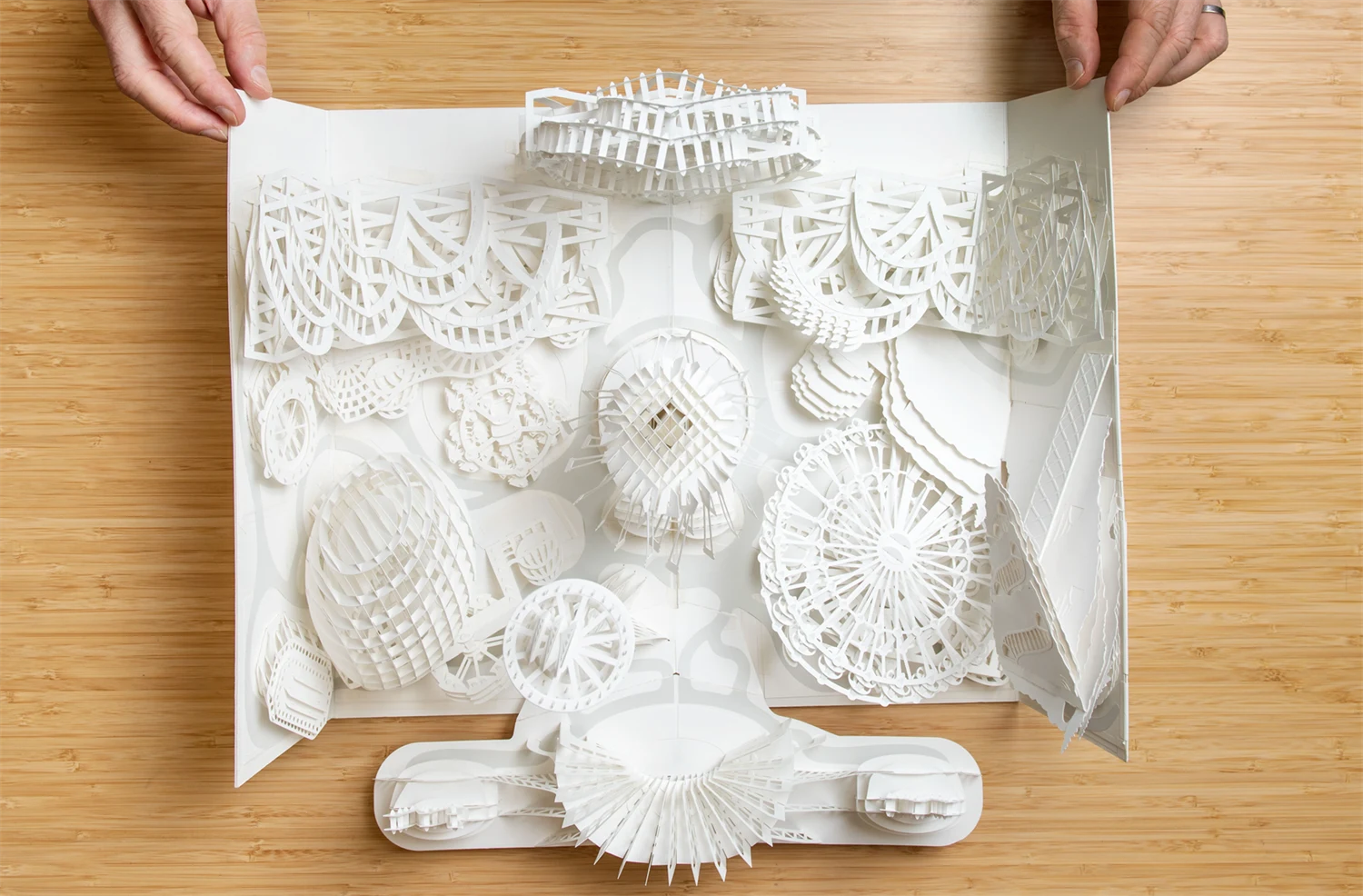The 3D pop-up paper model that German paper engineer and artist Peter Dahmen created for the feature film Wendell and Wild is called the Dream Fair. In the stop motion animated film, which was released in 2022 and distributed by Netflix, two demon brothers, Wendell and Wild, dream about making a fairground for departed souls. They present their vision for the fair as a 3D pop-up paper model.
“Wendall and Wild was the most amazing project that I have worked on,” says Dahmen. “The film team allowed me as much artistic license as possible. They told me to go crazy and wild and create something beautiful.
Dahmen says he works in a niche of niches as a professional 3D pop-up paper artist. But he started his career as a more traditional graphic designer, after studying Visual Communication at university in Dortmund over 30 years ago.
“It was during my studies that I discovered that I love to create pop-up models,” he says. “I am interested in the magic that happens, the transformation from something flat into 3D. And while all paper engineers have their own specialization, I prefer to make pop-ups from white paper. The white provides a contrast that interests me. My favourite paperboard is Invercote from Holmen Iggesund. It has a very pleasant white tone that is suitable for my work.”

Peter Dahmen and the Dream Fair pop-up paper model.
© Ibrahim Gonzalo.
Dahmen kept on making pop-up models as a hobby while working as a graphic designer. Then, in 2010, he posted a one-minute film of his models on YouTube, called Six Amazing Pop-Up Paper Sculptures. It was a sensation, gaining 1 million views within a year and almost 5 million to date. It launched his career as a freelance 3D pop-up paper engineer.
His work over the years has included making models for stage sets at conferences and 3D models of actual buildings that architects have designed. His more regular work, if you can call it that, includes designing seasonal pop-up greeting cards. He designed corporate Christmas Cards for Holmen Iggesund too.
“Invercote G, which I used for the Dream Fair, has the best qualities for the field that I am working in because it has a higher sturdiness compared to the paper weight. When you create a fold, Invercote G won’t fall apart. If you open it a thousand times it will always stay connected. This is especially important for a project like the Dream Fair that consists of so many individual elements. You don’t want it to break apart during filming.
“Invercote G’s clean-cut edges were also important for the Dream Fair as they filmed scaled down models,” Dahmen continues. “With some other paper there might be fibers sticking out. And Invercote G is very sturdy in all directions, regardless of the direction of paper grain. The consistently good quality was important for the Dream Fair project because I needed to be sure it would be reproducible. If I did a prototype the next model needed to have exactly the same quality. The availability of lighter and heavier paper weights also made Invercote G ideal, because the film crew could then scale the models up or down accordingly while keeping the same sturdiness ratio. It doesn’t limit my creativity.”
Dahmen says he works very much by intuition. He initially builds rough models by hand for the technical structure. If it works he disassembles all the pieces, scans them and then draws the shapes with software. He then prints these, cuts them and assembles them to see his errors before refining them. “Every new project starts with trial and error,” he says. “With a lot of error! But this is how I achieve the best solutions. I built the swing ride for the Dream Fair 15 times before it was perfect.”
The entire Dream Fair 3D pop-up paper model took Dahmen five months to design. It consists of over 1370 individual components. “The complexity of this model was beyond good and evil and insane,” he says. “It is crazier and more complex than everything I did before.”
A seasonal pop-up card, for comparison, would usually consist of around ten components and take Dahmen about two weeks to design. And a 3D model of a building for an architect would have between 50-70 components and take around six weeks. “I have never worked on a single model for five months before,” he says referring to the Dream Fair.
The complexity of the project arose primarily from Dahmen’s vision to include parts opening up in as many different directions and movements as possible. “I made many individual elements that I could move around the backing sheet in order to see how to open it all up without carousels crashing into each other,” he says. “I wanted every individual image in the pop-up film scene to be spectacular.”
Dahmen thinks that he is unlikely to work on something as complex as the Dream Fair project again. But his new-found connection with Hollywood has already resulted in him working on a commercial created by the Jim Henson company, most famous for creating The Muppet Show.
"I never expected that my pop-up art would see me work in so many different fields,” he says. “And just when I think I have been given the most exciting project there is, an even more spectacular assignment comes along. The Dream Fair might be hard to beat though!"
Facts
You can see the scenes with the Dream Fair in Wendell and Wild on Netflix at approx. 0:19:14 and 1:36:14 minutes.
Dahmen made all the pop-up elements for the Dream Fair from Invercote G. For most of the elements he used Invercote G with the weight of 220 g/m2.
Created 4 July, 2023.


